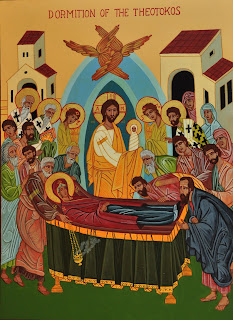| Christ of Sinai on cypress |
Christ of Sinai
An
unusual icon, from St. Catherine’s Monastery on Mt. Sinai, has greatly
impressed many people over the years because it seems more like a personal
portrait of Christ than the sort of icon they have experienced before. It was
probably painted in the court of Emperor Justinian in Constantinople in the 6th
century and sent to St. Catherine’s Monastery as the Emperor’s gift to the
monastery he had established in the Sinai desert.
I
have painted the icon a number of times, but one day I began to see it in
another way. I have always loved the
look of weathered wood, especially when it turns a lovely silvery gray, and one
day I chanced to come upon a pile of slab wood out in the country. Wood is so significant in the Bible: God
created the Tree of Life in the Garden of Eden; He instructed Noah to make an
Ark of wood; He hung from a wooden Cross.
God created all things, and He is in all things. This weathered wood seemed a fitting medium
for an icon of Christ, and this one in particular.
In my icon, I have omitted a background
as well as a gold leaf halo, so it would
appear as if Christ were materializing from the wood.
The following is an excerpt
regarding the Christ of Sinai icon from “The Open Door: Entering the Sanctuary
of Icons”, by Frederica Matthewes-Greene:
"This
icon differs from other icons in several ways.
It is more realistic, less stylized.
Christ’s face is also more natural-looking, more like a portrait. Refer to Egyptian or Roman paintings of the
first centuries A.D. and you will notice that this icon resembles them in the
expressiveness of the wide eyes and the subtle skin tones.
This
is probably one of the oldest surviving examples of Christian art. It was painted mid-6th century
probably in the imperial capital of Constantinople ,
to judge by the fineness of its execution.
It has spent its existence in Sinai which accounts for its
survival. The earliest Christians have
gone here to live in caves as monastics near the site of the Burning Bush and
the mountain where Moses received the Law.
After years of attacks by Bedouin tribes, Emperor Justinian built a
walled monastery here around 550 AD. It
is now named for St. Catherine of Alexandria
The
icon is of the type called Pantocrator, which means Ruler of All. In this type of icon Christ is often revealed
as the eternal judge, and may be shown sitting on a throne. His right hand is raised in blessing and in
his left hand is a massive Gospel book.
In some icons the book is closed, and in others there might be a passage
from the Gospels.
Although
most icons are written in egg tempera, this one uses a much earlier method
called wax encaustic, where melted wax is mixed with powdered pigments. In 1962 the layers of grime from incense and
candle smoke were cleaned to reveal the original.
This
icon has been said to have the ability to look into one’s soul. The artist has achieved this is through the
distortion of perspective. Notice how
large the Gospel book is, and that the “vanishing point” is ourselves, not
Christ. We have the feeling that He is
viewing us, rather than we, Him.
As
we look at this icon we see how ancient His love is. He was loving us before we ever turned to
look into these eyes. He has been loving
us a long time, from a Cross two thousand years before we were born. We don’t have to improve, or cover up our
faults, to earn this love. It has been
surrounding us all our loves, waiting for us to receive it. Perhaps that is the meaning of the faint
smile. He loves us too much to let us
remain as we are, confused and mired in sin, hurting others and ourselves. He will heal us, and His healing is sure… There is great patience there. He is waiting; He is not in any hurry. He will be right here, even when you forget
Him and get tangled in your life again, and have to turn around and come back
to Him – not once, but over and over again.
-------------------
Western
religious paintings may seem accomplished and beautiful, but noisy. In a way that is hard to define, icons touch
a completely different interior level; deeper down there is a place where we
first confront life, before we decide what we think or feel about it. That is the intimate place where icons speak. They are companions in prayer. They have their fullest impact on those who
are saturated in prayer and Scripture, who participate in the full life of the
Church, with all her mysteries, hymns and worship.
Look
at Him again, and let Him look at you.
Take your time. You may have
things you want to say, and then you might run out of things to say and need
just to be silent before Him. This is a
quiet, but very deep, icon."















